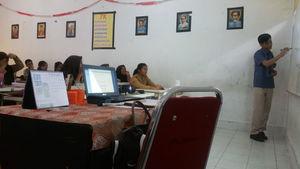Putting together the backbone of teaching
- Rogel John Naval

- Feb 15, 2018
- 3 min read
If you are a teacher, or at least a student who wishes to be a bona fide teacher someday, you know that you can't teach a class without a lesson plan. The lesson plan is the backbone of everyday teaching. Having a lesson plan gets us ready for the battle we teachers will face in making our students learn.
As mentioned in my previous posts, my mentor, Sir Affandi, provided me with the topics I will teach for the two-week period. He said I will teach financial profit, financial loss and break-even, and simple interest. The mathematics curriculum of Indonesia follows a spiral approach. This means that every year, they bring these topics up but the level of difficulty increases. This makes a lot of sense if you want your students to fully master the topic at hand. Comparing it to the new curriculum in the Philippines, both follow Bruner's constructivism theory. However, I got curious on why these were the topics given to me because in the Philippines, these are topics for grade 4 because what is given more emphasis in the junior high school are topics on algebra, geometry, statistics, and other maths that prepare them for college-level maths and higher mathematics subjects for their respective careers.
From another perspective, I think teaching social arithmetic topics during the junior high school years could be beneficial on the part of the students because the depth of the discussion is better than in the elementary years, plus, it will be easier to recall and will be more useful once they reach their adult lives as they experience these phenomena. From my experience, a lot of topics from the elementary level are difficult to recall since it was taught a long time ago. What makes it more difficult is that these topics that were taught in my elementary years are the ones usually encountered in the real life.
As I accept the topics I was supposed to teach, I received a copy of the lesson plan for financial profit. I was supposed to use that format to make my lesson plan. Certainly, it was in Bahasa Indonesia so my buddy, Darmia, had to translate the entire lesson plan in order to get me to understand what was written. On the lesson plan, a huge portion of it was devoted to the math curriculum of Indonesia. What I noticed was there are competencies that target the cognitive, affective, and psychomotor learning domains. It is different from the curriculum of the Philippines since, although it touches the three learning domains, it does not specify it for every topic. Usually it is the cognitive domain or the psychomotor domain. The teachers have to add to the missing competencies in order to make learning holistic.
I read further through the next pages and see the more familiar parts every lesson plan should have: learning objectives, topic, learning materials, learning activities/experiences, evaluation. In the learning experiences part, it seemed to be a semi-detailed lesson plan. What I like in the lesson plan is that every activity for the period should have an estimated time of how long it should be conducted. This way, the teacher can plan the time period wisely.
The evaluation portion of the lesson plan was quite different from what I was expecting. Usually in my lesson plans, I indicate the assessment prompt like the problems to solve, or the instructions to the activity. However, in this lesson plan, the only things indicated are what domain does it belong, what technique will be used to assess, and what time during the period will it be carried out. For example, the spiritual attitude will be assessed through observation during the preliminaries. This is determined by making sure the students pray before the start of class.
Although from two different nations, given the same set of theories and principles to follow, the teaching plan in Indonesia and Philippines would still be somewhat similar. What I can't deny is that the two curricula aims for the twin goals of mathematics -- critical thinking and problem solving. Those two were the things I kept in mind during my stay in Indonesia. If I didn't, what purpose does the curriculum and the lesson plan serve?






Comments